

William Stopford
Volkswagen ID. Polo: Electric city car detailed, but petrol power not dead yet
5 Days Ago
The N Division's first shot at a light hot hatch is nigh on a bulls-eye. It's a total hoot regardless of your skill level, and is ripper value for money.

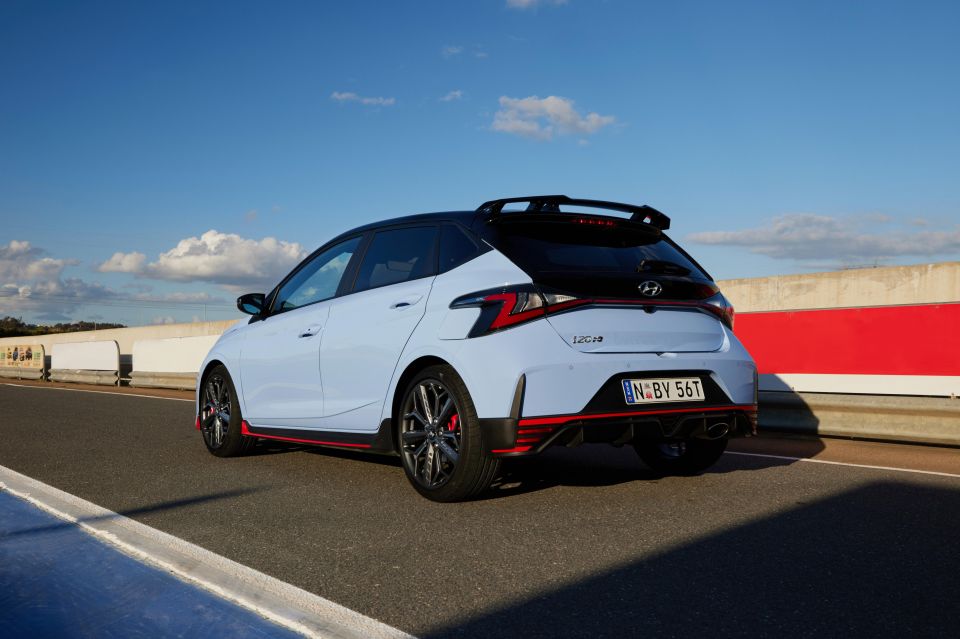

Marketplace Editor

Marketplace Editor


Marketplace Editor

Marketplace Editor
Where expert car reviews meet expert car buying – CarExpert gives you trusted advice, personalised service and real savings on your next new car.
It may be small, but the all-new 2022 Hyundai i20 N comes with big expectations.
Despite being the N Division’s first foray into the light hot hatch segment, or B-segment as they say in Europe, the i20 N has been met with critical acclaim overseas, and is the most affordable way into the brand’s performance line-up.
The Turkish-made pocket rocket has the Ford Fiesta ST and Volkswagen Polo GTI firmly in its sights, and claims to be the ultimate ‘corner rascal’. It’s also got strong genetic links to the i20 N Rally2 WRC car.
Priced at just over $32,000 plus on-road costs, a host of track-ready features, and a track-friendly warranty, can the i20 N live up to the hype? We attended the Australian media launch in Goulburn to find out.

The 2022 Hyundai i20 N is available in just one variant, unlike the i30 N and Kona N which give you a choice between standard and Premium flavours.
Pricing kicks off at $32,490 plus on-road costs, with the only cost options being select paint finishes: $495 for Dragon Red mica and $1000 for a Phantom Black contrast roof.
By comparison, the soon-to-be-updated Ford Fiesta ST costs $32,290, while a Volkswagen Polo GTI (also soon to be facelifted) starts at $32,890, but requires a few option boxes to match the equipment levels of the other two.
Not bad then, from Hyundai N.

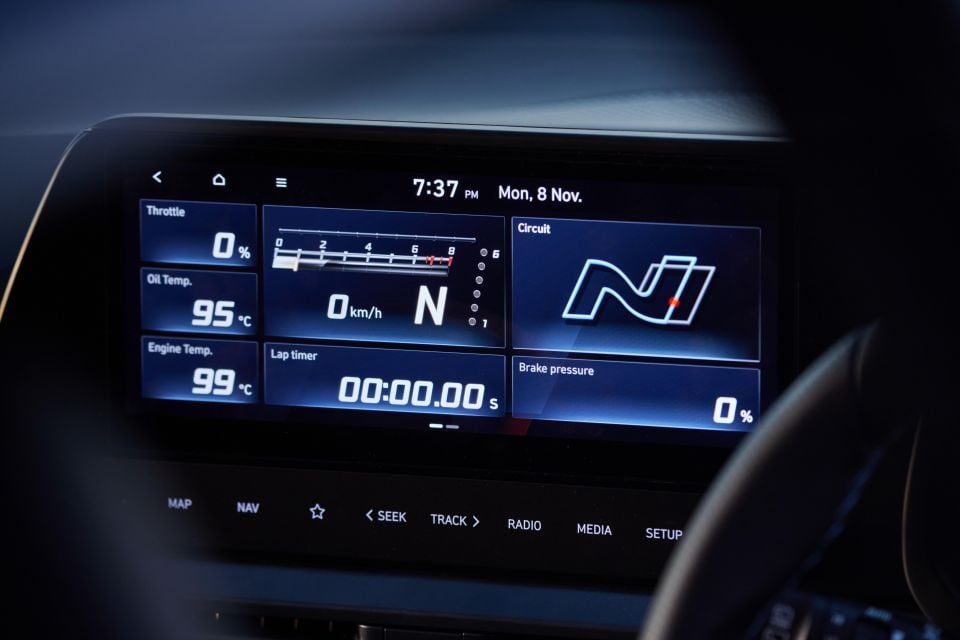


Buy your new car without the stress. It's fast, simple and completely free.

Great service from Travis and team, second time I have used this business would not hesitate to recommend them to anyone
Craig C.
Purchased a Ford Ranger in Sunshine Coast, QLD
CarExpert helped Craig save thousands on his Ford Ranger, now let us save you on your next new car.
Find a dealEquipment highlights include:
Hyundai has managed to fully load the i20 N with just about everything in its vast catalogue of features, though some may notice the absence of adaptive cruise control and a head-up display.
They’re definitely not deal-breakers, especially at this end of the market, though Aussies love sunroofs and the i20 N isn’t available with one, even as an option.

The latest Hyundai i20 hasn’t been crash tested by ANCAP or Euro NCAP.
Standard safety equipment includes:

Despite being the entry-level N car, the i20 N feels quite upmarket for a light city hatch.
While the interior plastics and surfaces are generally hard to the touch, there’s a variety of textures to break things up, along with the Performance Blue highlights throughout the cabin. Plus, there’s those gorgeous screens.
Measuring 10.25 inches each, there’s a display for the driver’s instrument binnacle as well as the central infotainment touchscreen. Both are running the latest Hyundai Motor Group software as we’ve seen in the Kona and i30 Sedan, and just like in those other lines the displays are excellent.




Crisp graphics, high refresh rates and snappy response make the i20 N feel as techy as anything else in the company’s range, and it’ll certainly appeal to younger types that have grown up with iPads and driving simulators.
There’s a Track Maps function that allows you to load a circuit into the system and time laps based on GPS. Hyundai Australia had the Wakefield Park track loaded into the system and the GPS-based lap timing seemed to work well. I managed a circa 1 minute 15 second lap using the function, and I’m a total newbie on track – more on that later.
Hop in the N front sports seats with integrated headrests, and you feel like the car just wraps around you. Comfort in is really good, with snug bolsters and good adjustment allowing for a comfortable driving position whether you’re on road or track.
Placement of the shifter and pedals also feels just right, and there’s good adjustment in the steering column (reach and rake) so the digital cluster is in easy view and the wheel itself feels nice in the hand.
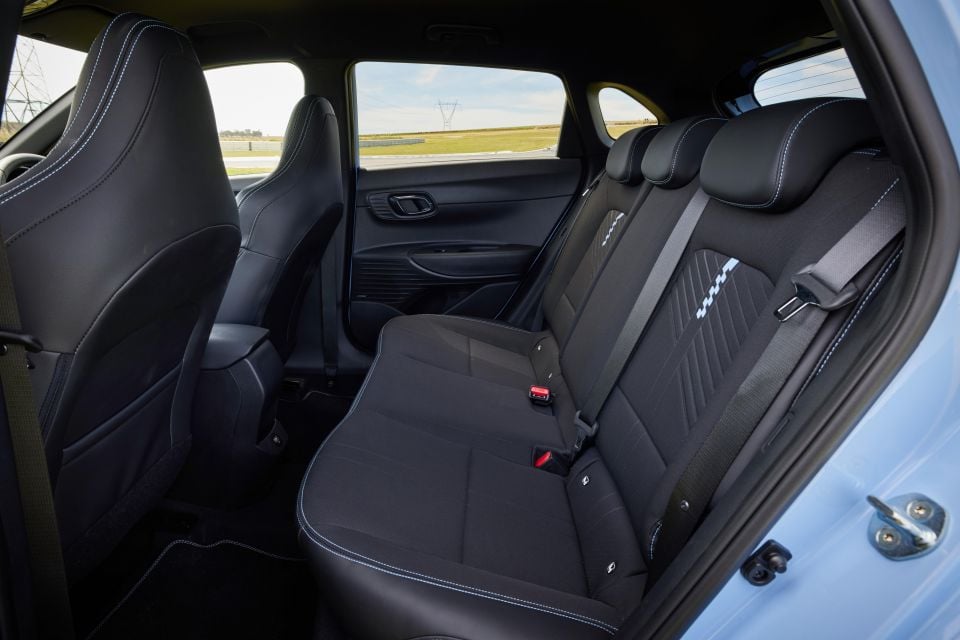
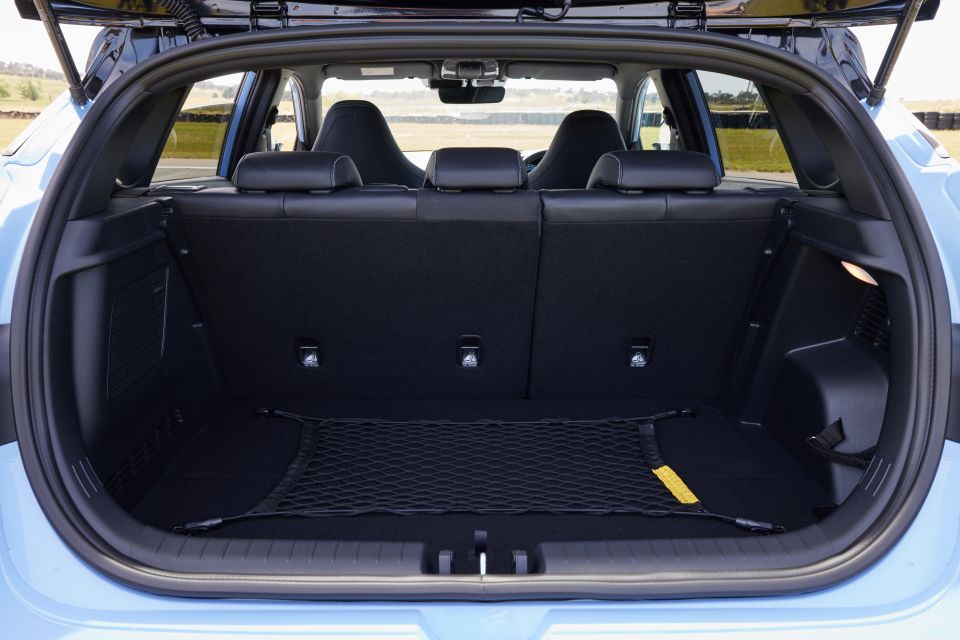
Speaking of which, the tiller is lifted straight out of the i30 N meaning it’s finished in creamy perforated leather and features N buttons to quickly change drive modes, as well as a bright red shortcut button for the rev-matching function.
Storage is pretty decent for such a small car, with a cubby under the centre stack large enough for a big phone plus a Qi wireless charger, cupholders between the front seats, and a small cubby under the front-centre armrest. Bottle holders feature in the front and rear doors, too.
Purists will also love the leather-wrapped manual handbrake, which like the trims throughout the cabin features Performance Blue contrast top-stitching.
We didn’t spend much time in the back seat given we were driving solo the entire launch, but there is adequate space for two adults in the back – a Polo is slightly bigger, Fiesta smaller – and there’s a decent 310-litre boot which expands to 1123L with the rear seats folded.

The i20 N features a 1.6-litre T-GDi four-cylinder turbo petrol engine, with quoted outputs of 150kW (5500-6000rpm) and 275Nm (1750-4500rpm). There’s also an overboost function that increases maximum torque to 304Nm under full throttle between 2000 and 4000rpm.
Drive is channelled through a six-speed manual transmission and a Torsen mechanical limited-slip differential on the front axle. The manual shifter features a reinforced clutch, upgraded friction materials, and redesigned synchros compared to Hyundai’s more mundane transmissions.
Additional features include Launch Control, an auto rev-matching function for the manual transmission, and a three-mode stability control system like other N cars.
Compared to the 1.6 T-GDi in vehicles like the i30 N Line, the i20 N gets a new turbo and intercooler, as well as a 350bar high-pressure fuel rail for faster engine response.
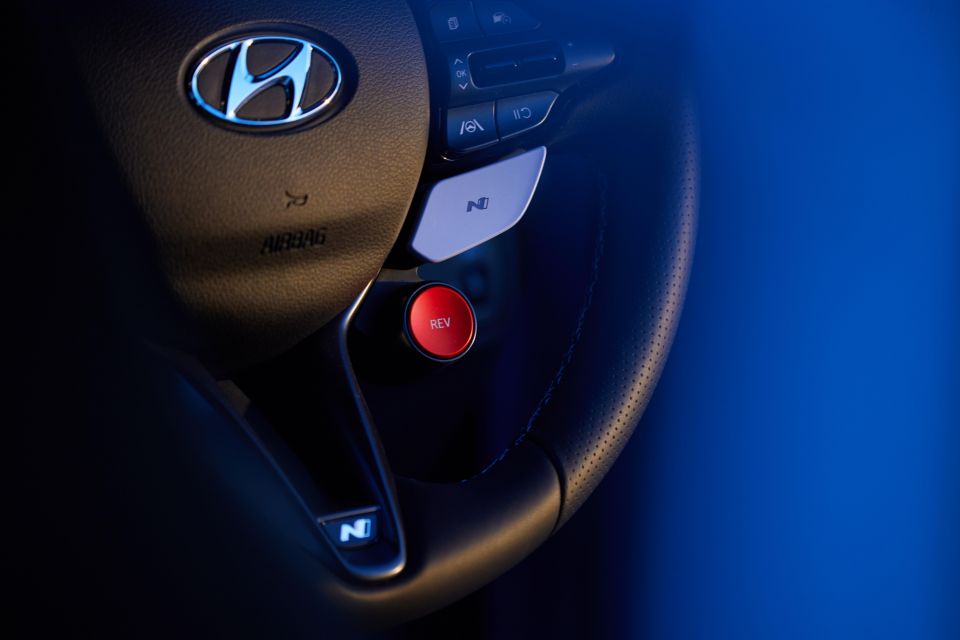
The i20 N’s motor also features some of Hyundai’s new powertrain tech to increase efficiency and response, such as Continuously Variable Valve Duration (CVVD), which regulates the duration of valve opening and closing according to drive conditions to cut fuel use and improve engine response.
When this technology was first revealed in 2019, Hyundai claimed the new engine cut fuel use by 5.0 per cent and emissions by 12.0 per cent, while achieving a performance boost of 4.0 per cent.
Hyundai claims the i20 N can dash from 0-100km/h in 6.2 seconds, and hit a top speed of 230km/h.
Interestingly, the i20 N’s powertrain is Euro 6-certified, and features fuel-saving idle stop/start technology. Fuel use is quoted as 6.9L/100km on the combined cycle, while the fuel tank measures 40L.

The part you’ve all been waiting for.
Fire up that little engine and you’ll hear a surprisingly strong bark from the exhaust. Hyundai N has become well-known for its vehicles’ emotive sound, and the i20 N is no different.
We started our drive program in Campbelltown in Sydney’s south-west, heading for the Silos Estate in Berry, NSW. The roads along our near 150km route included a mix of urban, highway, freeway, and winding mountain roads.
In town the i20 N is a pretty easy companion, with decent comfort in the seats and suspension as well as variable steering weight via the different drive modes. Like the i30 N, however, the clutch take-up point is a little high and the pedal itself quite springy, so you may find yourself occasionally mis-judging a take-off or nearly stalling it.

With peak torque coming in at 1750rpm, performance at urban speeds is effortless and getting up to freeway speeds is a breeze despite it being such a little car. Regardless of the drive mode the variable exhaust system sends out a raspy note that puts a smile on your face.
Something I really appreciate these days is a big-car feel on freeways, and the i20 N never feels nervous at higher speeds – remember this is a car developed primarily for the European market.
As tends to be the case with most European light cars, road-holding is excellent and it really inspires confidence even when you’re driving alongside B-doubles at 110km/h on rough country highways.
The six-speed manual is pretty easy to row in most conditions, even with the clutch as mentioned earlier, though at 110km/h in sixth the engine is buzzing away at nearly 3000rpm. If you have the car in N mode, you may find the exhaust mode a little boomy at those speeds, but I didn’t mind it.


Once things get twisty, the i20 N really comes alive.
That firmer suspension (MacPherson struts up front, torsion beam at the rear) translates to minimal body roll in the bends and a really hunkered down feel. It really is a ‘corner rascal’, as Hyundai refers to it.
Sharp turn-in, well-weighted, communicative and direct steering, as well as that trick mechanical diff up front means there’s seemingly limitless grip up front and it really gives you the confidence to push on. It’s a freaking hoot to drive, and it really feels like an extension of the driver.
My only real complaint during the road drive was that the firmer ride and tyre roar over some really rough coarse-chip blacktop meant long-distance driving can get a touch tiresome. Remember though, this is based on a city-focused light hatchback.
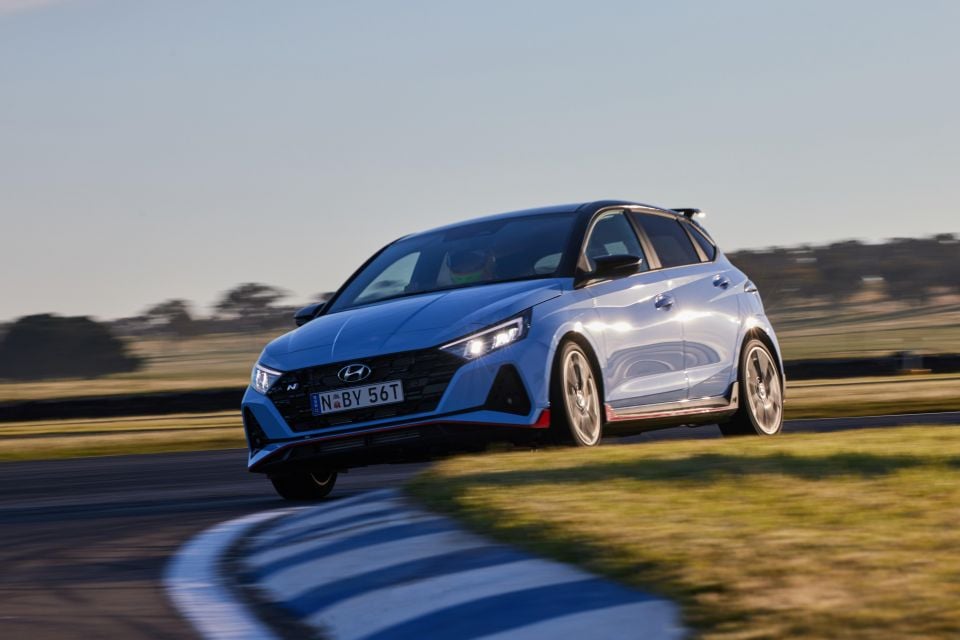
Following a day of road driving in the i20 N and Kona N (review for that coming December 3), we spent a day putting both vehicles through their paces around Wakefield Park circuit in Goulburn, NSW.
Wow, did the i20 N really shine here.
As I noted earlier, I haven’t spent much time on a racetrack. The i20 N really made me feel comfortable and it certainly feels at home on the circuit.
It’s so well tuned in every respect that it shrinks around you and communicates what’s going on so clearly. I always felt like I had a clear idea of what was going on underneath me, and every input was met with a predictable output.

Where expert car reviews meet expert car buying – CarExpert gives you trusted advice, personalised service and real savings on your next new car.
With such communicative controls and a running package that offers so much grip right out of the box, the i20 N gives you the confidence to push further and further to explore the vehicle’s limits. I definitely didn’t find the limit – cue Lindsay Lohan in that scene from Mean Girls: “the limit does not exist”.
Not once did the mechanical front diff fail to shuffle torque to the outside wheel to ensure the car went where I pointed it. It’s got so much grip and feedback that you can pretty much just point and shoot. The slick manual shift and rev-matching function also make you feel like a hero every time you downshift into a corner.
Go even harder with the stability and traction control in their track settings and you can get a bit of lift-off oversteer and shuffle the i20 N mid-corner to get it moving around. It’s super playful but also predictable so you never feel like you’re going to lose control.
Under brakes the i20 N offers good stopping power even after consecutive laps, helped no doubt by its fairly lithe 1210kg kerb weight

Champion rally driver Brendan Reeves took me on a hot lap in both the i20 N and Kona N, and I felt like I had just been casually coasting around the track the whole time.
Somehow managing to give a conversational tutorial while absolutely wringing the i20 N’s neck, Brendo really demonstrated how capable this little thing is on the track. In the passenger seat the experience was nothing short of wild, and I’m pretty sure I saw the speedo tick over 170km/h on the main straight of Wakefield Park.
I came away realising how broad the i20 N’s skillset is, given it’s a great first track car but also rewards the skills and demands of a much more experienced driver.
All told, this is a fantastic little driver’s car.

The 2022 Hyundai i20 N is covered by a five-year, unlimited-kilometre warranty.
As with other Hyundai N models, the warranty also includes vehicle use on non-competition track events as well as the use and fitment of track-focused tyres.
Servicing is required every 12 months or 10,000km, whichever comes first. The first five services are capped at $309 a pop.
Fuel consumption during our time with the vehicle probably wasn’t indicative of real-world use, but following our lengthy road drive the trip computer showed 7.1L/100km after some spirited country driving and long highway stints. Not bad, and the idle stop/start didn’t engage once because I had it in N Custom mode because, rawr.
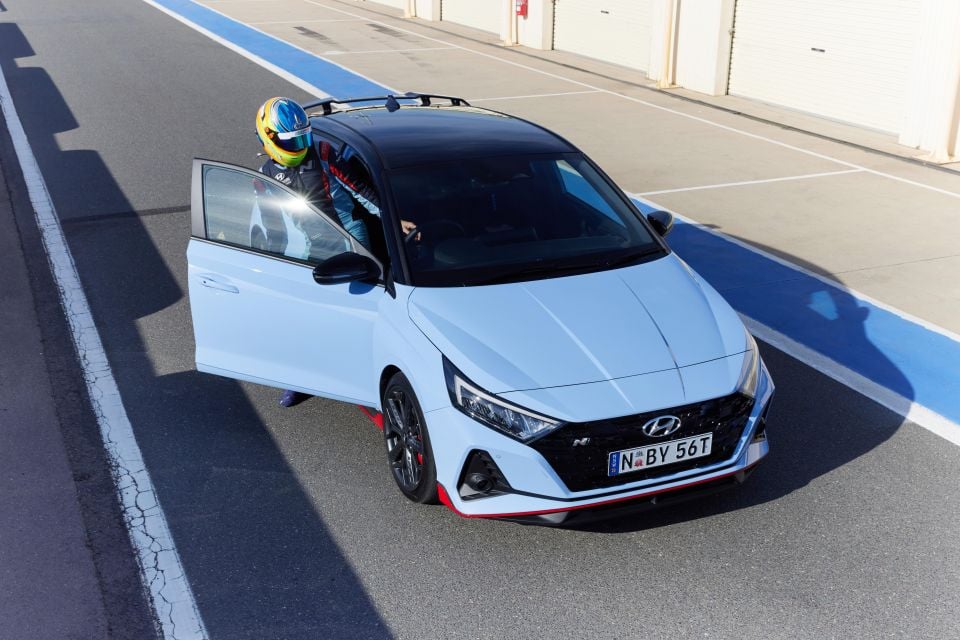
Long story short, it’s brilliant.
Hyundai is really stamping itself as a serious player in the affordable performance market. The i30 N walked so the i20 N could run.
Jokes and meme references aside, the i20 N offers engaging, smile-inducing dynamics, muscular performance, strong track capability and excellent value for money against its competitors.
Considering it’s the N brand’s first stab at an entry-level performance product, the i20 N comes off as a mature, well-evolved product with generations of development. Whatever the team is doing, keep doing it.

Click the images for the full gallery
MORE: Everything Hyundai i20
Where expert car reviews meet expert car buying – CarExpert gives you trusted advice, personalised service and real savings on your next new car.
James Wong is an automotive journalist and former PR consultant, recognised among Australia’s most prolific motoring writers.


William Stopford
5 Days Ago


William Stopford
6 Days Ago


William Stopford
12 Days Ago


Josh Nevett
21 Days Ago


William Stopford
1 Month Ago


William Stopford
2 Months Ago